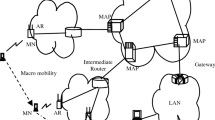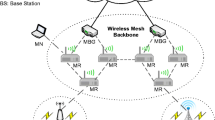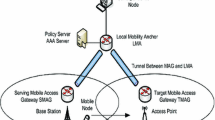Abstract
With the almost ubiquitous availability of wireless networks and the increasing communication capabilities of portable devices, the prediction that most IP-based mobile nodes are constantly connected to the wireless networks is fast becoming a reality, Hence, providing mobility support in IP networks has been a long-standing challenge. Although various proposals tried to tackle the Route Optimization (RO) problem, none of them has achieved a satisfactory success. Furthermore, most of them are not a comprehensive solution for coexisting MIPv6 and PMIPv6 mobility environments. In this paper, we focus on challenges to support both MIPv6 and PMIPv6 coexistence from the same wireless access network. This means wireless access network need to support both mechanisms and interaction between them. We first propose a universal IP mobility framework based on a mobility protocol selection method, which takes into account the mobility capabilities of mobile nodes. This allows it to select the most suitable mobility supporting protocol between the MIPv6 and PMIPv6, which can significantly improve the convenience of wireless access network management. Subsequently, in order to reduce the signaling load and handoff latency, we propose a new scheme to reduce the signaling messages of MIPv6 route optimization for support across the MIPv6 and PMIPv6 mobility domains, which can significantly improve the overall performance of mobility management schemes, regardless the mobility environments in which the MNs reside. Simulation results show that proposed framework can improve the performance in terms of the route optimization latency, end-to-end latency, signaling cost, and throughput compared to original MIPv6 route optimization mechanism. Besides, the deployment complexity of both network entities and clients, are expected reduction.




















Similar content being viewed by others
References
Koodli RS, Perkins CE (2007) Mobile Inter-networking with IPv6: Concepts, principles and practices. Wiley-Interscience, USA
Perkins C, Johnson D, Arkko J (2011) Mobility support in IPv6. IETF RFC 6275
Gundavelli S, LeungK, DevarapalliV, ChowdhuryK, Patil B (2008) Proxy mobile IPv6. IETF RFC 5213
Kempf J (ed) (2007) Goals for network-based localized mobility management (NETLMM). IETF RFC 4831
Kempf J (ed) (2007) Problem statement for network-based localized mobility management (NETLMM). IETF RFC 4830
Giaretta G (2012) Interactions between proxy mobile IPv6 (PMIPv6) and mobile IPv6 (MIPv6): Scenarios and related issues, IETF RFC 6612
Damic Det al (2008) Proxy mobile IPv6 indication and discovery. Internet-draft: draft-damic-netlmm-pmip6-ind-discover-03
Han B-J, Lee J-H, Chung T-M (2008) Hybrid PMIPv6 indication mechanism for interaction between MIPv6 and PMIPv6. International conference on mobile technology, applications, and systems (Mobility ‘08)
Velev G, Weniger K (2008) Interactions between PMIPv6 and MIPv6: route. Optimization issues. Internet-draft: draft-velev-netlmm-mip-pmip-ro-01
Huachun Z et al (2010) A proxy mobile IPv6 based global mobility management architecture and protocol. Mobile Netw Appl (MONET) 15(4):530–542
Gang S et al. (2012) Cost analysis of a novel mobility management: interworking between PMIPv6 and MIPv6. 8th International conference on wireless communications, networking and mobile computing (WiCOM 2012)
Jong-Hyouk L et al (2010) Cost analysis of IP mobility management protocols for consumer mobile devices. IEEE Trans Consum Electron 56(2):1010–1017
Soochang P et al. (2010) Inter-domain roaming mechanism transparent to IPv6-Node among PMIPv6 networks. IEEE 71st vehicular technology conference (VTC 2010-Spring)
ETSI (2013) Architecture enhancements for non-3GPP accesses. 3GPP TS 23.402 version 11.6.0 Release 11
Saxena PC, Jasola S (2006) Performance of intelligent Mobile IPv6. Comput Stand Interfaces 28(6):737–751
Nikander P, Arkko J, Aura T, Montenegro G, Nordmark E (2005) Mobile IP version 6 route optimization security design background. IETF RFC 4225
Aura T, Arkko J (2002) MIPv6 BU attacks and defenses, internet-draft: draft-aura-mipv6-bu-attacks-01
Vogt C, Arkko J (2007) A taxonomy and analysis of enhancements to mobile IPv6 route optimization. IETF RFC 4651
Jonathan P (2002) SCADA security strategy. Plant data technologies
Pwn2Own 2010 (2010) http://dvlabs.tippingpoint.com/blog/2010/02/15/pwn2own-2010. Accessed 25 June 2011
Black Hat USA 2010 (2010) http://www.blackhat.com/. Accessed 25 June 2011
Gundavelli S (2012) Reserved IPv6 interface identifier for proxy mobile IPv6. IETF RFC 6543
Muhanna A et al. (2010) Binding revocation for IPv6 mobility. IETF RFC 5846
Deering S, Hinden R (1998) The internet protocol version 6 (IPv6) specification. IETF RFC 2460
Conta A, Deering S, Gupta M (2006) Internet control message protocol (ICMPv6) for the internet protocol version 6 (IPv6) specification. IETF RFC 4443
Koodli R (2008) Mobile IPv6 fast handovers. IETF RFC 5268
Author information
Authors and Affiliations
Corresponding author
Rights and permissions
About this article
Cite this article
Jia, WK. A Universal IP Mobility Framework with Compulsory Route Optimization for MIPv6 and PMIPv6 Coexistence. Mobile Netw Appl 19, 731–744 (2014). https://doi.org/10.1007/s11036-014-0552-5
Published:
Issue Date:
DOI: https://doi.org/10.1007/s11036-014-0552-5




